
The Zuiderzee or Zuider Zee was a shallow bay of the North Sea in the northwest of the Netherlands, extending about 100 km inland and at most 50 km wide, with an overall depth of about 4 to 5 metres (13–16 feet) and a coastline of about 300 km. It covered 5,000 km2 (1,900 sq mi). Its name is Dutch for "southern sea", indicating that the name originates in Friesland, to the north of the Zuiderzee.

Urk is a municipality and a town in the Flevoland province in the central Netherlands.

Hoorn is a city and municipality in the northwest of the Netherlands, in the province of North Holland. It is the largest town and the traditional capital of the region of West Friesland. Hoorn is located on the Markermeer, 20 kilometers (12 mi) east of Alkmaar and 35 kilometers (22 mi) north of Amsterdam. The municipality has just over 73,000 inhabitants and a land area of 20.38 km2 (7.87 sq mi), making it the third most densely populated municipality in North Holland after Haarlem and Amsterdam. Apart from the city of Hoorn, the municipality includes the villages of Blokker and Zwaag, as well as parts of the hamlets De Bangert, De Hulk and Munnickaij.

West Friesland is a contemporary region in the Northwest of the Netherlands, in the province of North Holland.
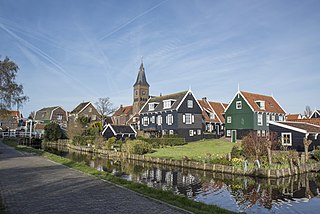
Marken is a village in the municipality of Waterland in the province of North Holland, Netherlands. It had a population of 1,745 as of 2021, and occupies a peninsula in the Markermeer. It was, until 1957, an island in the former Zuiderzee. The characteristic wooden houses of Marken are a tourist attraction.
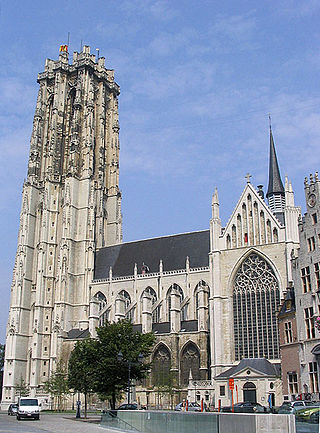
St. Rumbold's Cathedral is the Roman Catholic metropolitan archiepiscopal cathedral in Mechelen, Belgium, dedicated to Saint Rumbold, Christian missionary and martyr who founded an abbey nearby. His remains are rumoured to be buried inside the cathedral. State-of-the-art examination of the relics honoured as Saint Rumbold's and kept in a shrine in the retro-choir, showed a life span of about 40 years and a death date between 580 and 655, while tradition had claimed 775 AD.

The Markerwaard is the name of a proposed, but never built, polder adjoining the IJsselmeer in the central Netherlands. Its construction would have resulted in the near-total reclamation of the Markermeer.

The Zuiderzee Museum, located on Wierdijk in the historic center of Enkhuizen, is a Dutch museum devoted to preserving the cultural heritage and maritime history from the old Zuiderzee region. With the closing of the Afsluitdijk on May 28, 1932, the Zuiderzee was split in two parts: the waters below the Afsluitdijk are now called the IJsselmeer, while the waters north of it are now considered to be part of the Waddenzee.

Aartswoud is a village in the Dutch province of North Holland, part of the municipality of Opmeer. It lies about twelve kilometres (7.5 mi) northeast of Heerhugowaard.
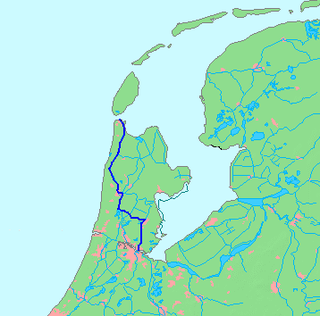
The Noordhollandsch Kanaal is a canal originally meant for ocean-going ships. It is located in North Holland, Netherlands. The canal was of great significance in Dutch history.

The KNSM Island is a man-made island in the Eastern Docklands of Amsterdam. KNSM stands for the Koninklijke Nederlandsche Stoomboot-Maatschappij, the Royal Dutch Steamboat Shipping company which used to have its headquarters and its docks on the island. It is now a large residential area containing modern architecture with a mostly well-off population.
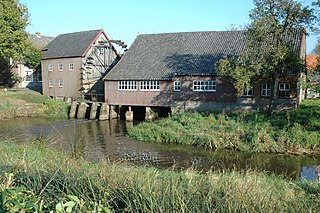
The Watermill at Opwetten is a watermill along the river Kleine Dommel, located on the Opwettenseweg 203 in Opwetten, Nuenen, Gerwen en Nederwetten, in the province of North Brabant, Netherlands. First mentioned in the 11th century, the watermill burned down and was rebuilt in 1764.

Henricus Petrus Cornelis (Kees) Verschuren is a Dutch sculptor, painter and former lecturer at the Willem de Kooning Academie in Rotterdam, known for his monumentalist sculptures in public places in the Netherlands.

Land reclamation in the Netherlands has a long history. As early as in the 14th century, the first reclaimed land had been settled. Much of the modern land reclamation has been done as a part of the Zuiderzee Works since 1919.

HNLMS Heiligerlee, formerly known as Panter, was a Heiligerlee-class monitor built in England for the Royal Netherlands Navy in the 1860s. Among the new ships built for the Dutch navy Heiligerlee was the first true monitor: a ship with shallow draught, only a few (heavy) guns and decent armor. These characteristics made her very suitable to operate way inland in the Dutch delta.

Museum Møhlmann is a privately owned museum for Dutch realistic and figurative art. It is situated in Tjamsweer near Appingedam in the province of Groningen in the Netherlands. The museum was founded in 1998 in Venhuizen and moved to its new location in 2008.
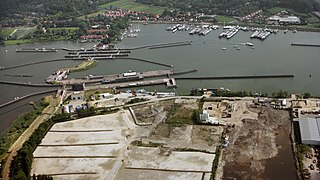
The Oranje Locks are a group of locks and other water management facilities just east of Amsterdam.

Elizabeth Frederika van den Ban, known as Elze, was a Dutch urban planner and chief engineer of the Rijkswaterstaat at Zuiderzee Works where she introduced curvatures rather than straight lines into the urban planning process of polders and dikes. Van den Ban was the first woman from the Netherlands to graduate as a civil engineer in Delft, where she worked as a civil engineer.

Harmen M. Krul is a Dutch politician of the Christian Democratic Appeal (CDA) and a former Royal Netherlands Navy officer. Krul was mostly raised in Den Helder and joined the Royal Naval College in 2013 after graduating high school. He served as a naval officer, rising to the rank of lieutenant before becoming secretary on the boards of two professional associations for officers in 2020.

The Oostereiland in the Dutch city of Hoorn is an artificial island built between 1662 and 1668. It was constructed from dams which were then raised and broadened. Soon after construction, homes and warehouses were built on the island, including a warehouse for the Admiralty of the Noorderkwartier.































